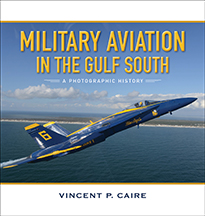
160 pages / 9.50 x 10.00 inches / 17 color photos, 142 halftones
History / Military History | Transportation / Aviation History
VINCENT P. CAIRE, writer and producer of the public television documentary film Sky Riders: Louisiana’s Aviation Pioneers, is the author of Louisiana Aviation: An Extraordinary History in Photographs. He has also contributed to Air and Space Smithsonian magazine and Aviation International News, among other publications. In 1986, Caire earned his private pilot’s license at New Orleans Lakefront “Shushan” Airport and now serves as director of the Port of South Louisiana Executive Regional Airport.
“The Gulf South’s contribution to the field of aviation is a great point of pride for its people. Vincent Caire more than proved his devotion to aviation history with this publication. The images depicted in these pages demonstrate how early airplanes and their pilots helped win wars, improve efficiency of transportation, and revolutionize modern flight design. Caire vibrantly portrays how these pioneers of flight influenced the field of aviation as we know it. The viewer has the advantage of a fresh, realistic perspective into the immense courage and resourcefulness required by these engineers of aviation.
My grandfather was a pioneer in aviation and his love for flight began around 1910 when, as a young farm boy he saw an airshow at the state fair in Shreveport, Louisiana. He studied aviation from the first time he sat in an airplane and his resulting innovative ideas about fighter tactics are now credited by many as having saved China during the Anti-Japanese War. He is now known as the “Father of Tactical Pursuit” in our modern-day Air Force. He would be very proud to be included in this beautiful pictorial book showing his contribution to flight as we know it.”—Nell Callaway, President, Chennault Aviation & Military Museum
Found an Error? Tell us about it.